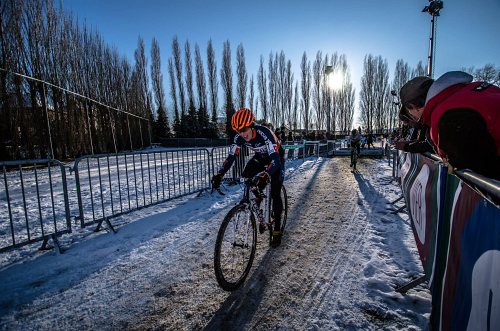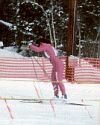Belgium Adventure 2014-15: Diegem and Loenhout
Superprestige Diegem
The morning of Diegem we awoke to a dusting of snow on rooftops and visible off in the hills. As we drove toward Diegem, it became clear that the eastern part of Belgium had gotten a more significant storm. Diegem had received several centimeters of crusty snow on top of ground that was not frozen. Temperatures were below freezing and remained that way for the 2:00 pm women's start, though it felt much warmer in the sun. Because the ground was not frozen, tires ground in the snow and brought up grass, water, and mud.
Turns out that Belgium is subject to the same laws of science as the rest of the world. Water and mud exposed to below freezing temperatures freezes...onto the bike. These are tough conditions for a mechanic. In the U.S., we often resort to breaking the frozen mud off the bikes with our hands. However, our crew proved themselves up to the task of cleaning in these conditions. The most useful gadget they had on hand? A simple hotpot. Utilizing the generator for electricity, they were able to work out of a large basin of warmed water. It had to be a lot of work, and I don't know the details, as I busied myself with pre-riding and warming up, but I do know that they provided shiny, clean bikes for 5 riders.
So many times I have grumbled when race promoters' hoses freeze up at U.S. races. Turns out the same challenges present themselves in Belgium. The pit power washers were temporarily frozen up in the morning (although running by race time).
Waiting to be called up at European race of this caliber is memorable. While I've been in the same race as Katie Compton and Katerina Nash many times in the U.S., I am more intimidated by Marianne Vos. With her wins across disciplines, Vos is simply in a different league. It was pretty cool to be in the grid, in a beautiful foreign city, when Vos (and Ellen Van Loy and Pauline Ferrand-Prevot, etc.) were called up. As I stood at the start, and looked around me, I thought, enjoy this. You don't get to do this forever.

Diegem is a city course utilizing city streets, athletic fields, random patches of public green spaces, a set of brick stairs, and an alley. Being in the city, it is spectator-friendly, and because it uses only small bits of grass here and there, rather than a park, the damage to the grass is forgivable.
I placed 31st out of 54 and finished on the same lap as eventual winner Vos.
After the race, I completed a cooldown, and we rushed home to watch the men's race on television. The men's race in Diegem takes place after sundown, which meant it got colder as they raced. It was a pleasure to be home in the warmth with our feet up watching the race on real television rather than streamed on the internet as at home.
(Photo: Tom Prenen)
Bpost Bank Trofee Loenhout
I am spoiled over here.
My life as a racer in the U.S. is often frantic and improvised. While I can depend on The Fix Studio for full service support at Midwestern races and Nationals, I often travel alone to races outside of our region. At those races, it's often me, 2 heavy bike boxes, a trainer, and my handy-dandy collapsible pit bucket. Last year, Belgium was the same: my husband Michael and I making do, cleaning, cleaning, and cleaning bikes, and trying to find our way to and around the race venues. I think I survived the trip fueled by adrenaline alone.
Having hired Gregory and his team has made all the difference. It's similar to the support that I've grown accustomed to from The Fix with the added bonus of being able to rely on locals to help navigate the venues.
As in the U.S., every aspect of this sport is competitive, including who gets the best spot to warm-up etc. at the venues. The best spot is defined by location relative to the course and bathrooms, shelter from the wind, space to spread out, and a flat, dry space for trainers. On race morning, Gregory arrives ahead of us, texts us a location, and saves us a place to park. Gone, but not forgotten, are the days of my husband and I driving in circles looking for a place to park, the perfect place, or any place!
Loenhout was mud. While the snow had melted to the west of the country, Loenhout still had plenty. The race is notoriously muddy regardless of weather, so the melting snow and ice (it was well above freezing) made for epic conditions. The course has no off-cambers, but several flyovers and short sharp hills. Descending each, it was a matter of pointing the bike at a chosen mud rut, staying loose, and hoping for the best. The mud, as well as ditches, and hills post-holed with footprints, meant lots of running. We raced four laps and I switched bikes five times. It was one of the most exhausting races I have ever done.
Again, I finished on the lead lap; this time 30th.
Riding from the finish line to the vans, covered head-to-toe in mud and ice water, I got a little cold. At that moment, I was very appreciative of Denis's cargo van with heaters, a chair, and a changing space in the back. I was able to get into dry clothes and get a cooldown in, but many of the ladies went straight to the showers. When I took a shower later, I was grateful for the UCI rule that mandates that there be showers on site. We ladies created quite a layer of mud and slime across the locker room floors!
The mechanics finished up the bikes and started to spray themselves off and then ran out of water. For four athletes, and 8 bikes, they went through 250 liters of water. Keep in mind that neutral water is used at the pits, so this was only for washing after pre-riding and after racing. For those not mechanically inclined, that's 66 gallons! It takes half an hour to fill the tank.

